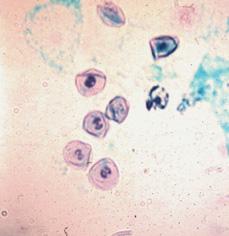Pneumocystis Pneumonia
Walter T. Hughes
Pneumocystis pneumonia (PCP) occurs almost exclusively in the severely immunocompromised host, especially patients with congenital immunodeficiency diseases, AIDS, and cancer, and those who have had organ transplantation. The causative agent is a protozoan-like fungus known for the past century as Pneumocystis carinii. Recently, the term Pneumocystis jirovecii has been proposed for the organism found in humans,1 but acceptance has not been universal.2
 EPIDEMIOLOGY
EPIDEMIOLOGY
Pneumocystis organisms have been found in the lungs of most mammals in most parts of the world. Transmission of the organism seems to be host-specific. The natural habitat and mode of transmission in man are unknown, but animal studies suggest animal-to-animal transmission occurs by the airborne route.3-5 Animal-to-human transmission has not been reported, and available evidence suggests that human-to-human transmission is possible.11
Considerable data show that at least 75% of normal children reaching 4 years of age have acquired antibody to Pneumocystis and that more than 90% of normal adults have detectable antibody.16-18,19 The incidence of PCP in cancer patients is influenced more by the extent of immunocompromise from treatment than the primary disease. In a controlled study of 160 children with acute lymphocytic leukemia without PCP prophylaxis and on intensive antileukemia therapy, 20% were found to have developed PCP.28 Other at risk populations include those immunosuppressed for solid organ transplantation30, rheumatoid arthritis, lupus erythematosus, and other connective tissue diseases in adults with CD4+ T lymphocyte counts less than 250/mm3.31
Early in the AIDS epidemic, when no antiviral therapy was available and chemoprophylaxis for PCP was not applied, some 75% of adults and 39% of infants with AIDS acquired PCP.32,33,34 In infants and children with HIV infection, PCP occurs most often in infants between 3 and 6 months of age.33-35 The use of PCP prophylaxis and highly active antiretroviral therapy (HAART) has profoundly reduced PCP in patients with AIDS. The Perinatal AIDS Collaborative Transmission Study showed a 95% decrease in PCP (cases per 100 patient-years), from 5.8 in the pre-HAART era to 0.3 in the HAART era.37,38
As with other immunosuppressed states, highly significant risk factor for PCP in HIV-infected patients is a marked reduction in the CD4+ T lymphocyte count.
 PATHOPHYSIOLOGY
PATHOPHYSIOLOGY
The portal of entry for Pneumocystis is believed to be the respiratory tract via the airborne route. In the infected lung, the organism is found in both cystic and extracystic forms. The cyst is a round, oval, or cup-shaped structure approximately 4 to 6 microns in diameter (Fig. 353-1). Within the mature cyst are as many as eight daughter cells, referred to as sporozoites, that are pleomorphic and often crescent shaped. These cells eventually excyst through breaks in the cyst wall. Outside the cyst, the daughter cell, now termed a trophozoite, varies from 2 to 5 microns in diameter. These thin-walled trophozoites tend to cluster in masses.
In the normal, healthy individual, Pneumocystis may lie dormant in the alveoli, eliciting no tissue response and leaving the host asymptomatic.42 In the severely immunocompromised host, organisms replicate to large numbers and an extensive diffuse alveolar disease and interstitial infiltration may progress to death.
Pneumocystis attaches to the alveolar epithelial cells, and alveolar macrophages ingest and degrade the organisms; this provokes neutrophil, lymphocyte, and monocyte infiltration and cytokine release. Alveolar disruption impedes gas exchange and leads to respiratory failure.43,44 The CD4+ T lymphocyte serves to recruit and activate other immune effector cells.45,46 There is an increase in CD8+ lymphocytes in the lungs.47 Surfactant phospholipids are reduced in PCP, further impairing pulmonary function.48-51

Stay updated, free articles. Join our Telegram channel

Full access? Get Clinical Tree


